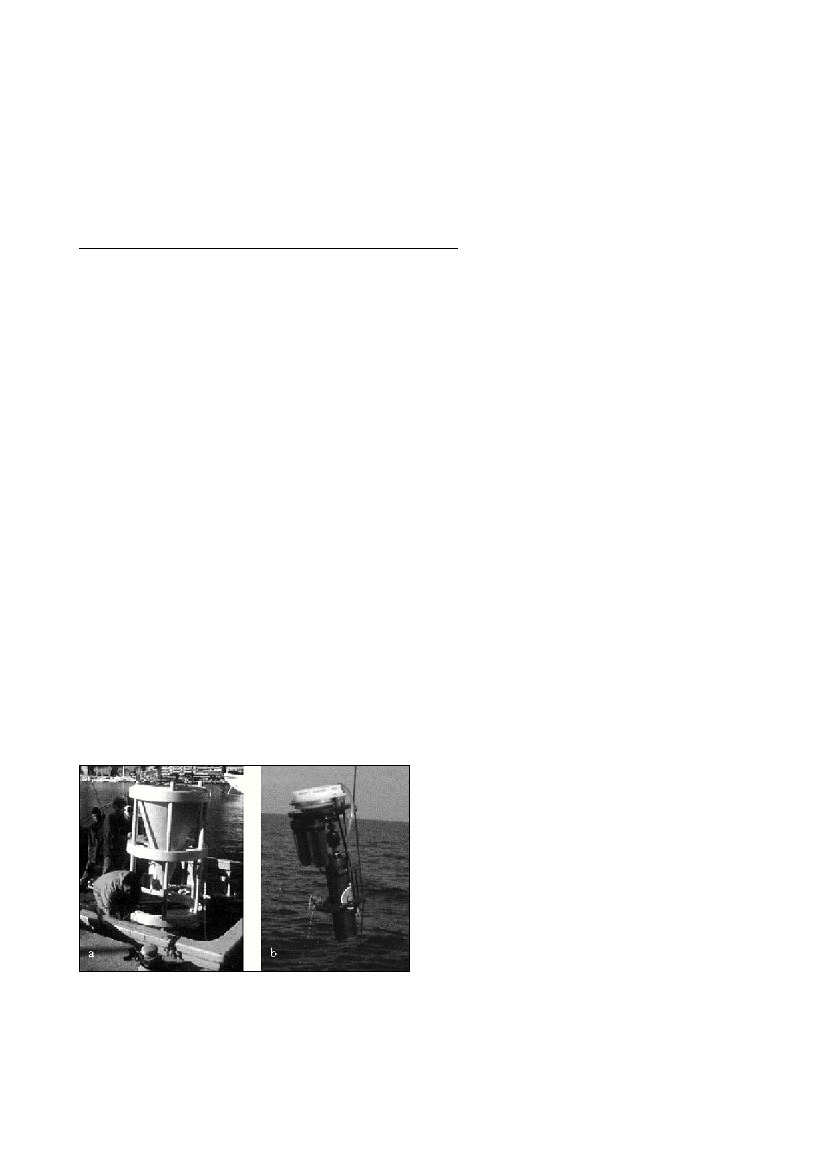Rapp. Comm. int. Mer Médit., 36,2001
146
Introduction
Sediment traps have been widely used over the past 30 years to
study the downward ?ux of particles under in various marine environ-
mental conditions. They are a unique tool for measuring particle ?ux
in the water column and for collecting samples to estimate ?uxes of a
variety of elements and compounds [1]. Also, they permit recording
?uxes over long periods of time to observe seasonal and annual
changes in sedimentation [2]. Their records have provided key data for
the better understanding of ocean biogeochemical processes. It is
widely accepted that traps deployed in calm environments or the deep
ocean provide a reasonable estimate of in-situsedimentation. The sit-
uation is not always the same when traps are deployed in high energy
environments or shallow waters. Trap data obtained under the latter
conditions may be affected by hydrodynamic bias [3].
Since the activity of
234
Th in sea water is primarily controlled by
production from its soluble parent
238
U and losses through radioactive
decay plus sorptive removal on sinking particles, the accuracy of trap
measurement in shallow waters can be verified by studying the
234
Th:
238
U disequilibria in the overlying water column. From the
234
Th deficiency in sea water one can predict the
234
Th ?ux down to
the depth of radionuclide disequilibrium [4]. Given this and a
234
Th
measurement in the traps, one has an independent check whether the
trap is collecting
234
Th-bearing particles in a predictable fashion. In a
similar way, carbon ?uxes can be predicted by using experimentally
determined C/
234
Th ratios.
Field test and results
During a spring bloom, a field intercomparison of the three
Technicap models of sediment traps (Fig.1a) was carried out off
Monaco. During one month the traps were deployed at 170 m depth on
three independent moorings over a bottom 370 m deep. Currents were
also recorded during the entire period of the experiment. In order to
relate the measured ?uxes to changes in the environment, using Niskin
bottles the water column was sampled weekly for basic physico-chem-
ical parameters such as temperature, salinity, ?uorescence, chlorophyll
aand particulate organic carbon. In addition, particulate and dissolved
234
Th were measured in the water column using in-sitularge volume
pumps (Fig.1b) in order to compare
234
Th trap-measured ?uxes with
?uxes predicted based on
234
Th-deficiency, and to estimate carbon
?uxes from the observed
234
Th:
238
U disequilibria.
Fluxes measured by the three sediment traps were in good agree-
ment during most of the sampling period. Only during short periods of
high sedimentation did the measured ?uxes present a high variability
between traps but without any consistent differences for any given
model. Similar trends were observed for carbon ?uxes and, to a lesser
extent, for pigment ?uxes. Thorium data, although preliminary, indi-
cate that
234
Th trap-measured ?uxes and predicted
234
Th ?uxes based
on
234
Th-deficiency were relatively similar and, thus, suggest that the
collection of particles by the traps was representative of the actual in-
situ?uxes off Monaco during the experiment.
References
[1] Fowler S.W. and Knauer G.A., 1986. Role of large particles in the
transport of elements and organic compounds through the oceanic water
column.Prog. Oceanogr., 16: 147-194.
[2] Miquel J.-C., Fowler S.W. and La Rosa, J., 2000. “Seasonal and
interannual variations of particle and carbon ?uxes in the open NW
Mediterranean: 10 years of sediment trap measurements at the Dyfamed
station. In: Ocean Biogeochemistry: A New Paradigm, JFOFS Open
Science Conference, Norway, p.133.
[3] Gust G., Byrne R.H., Bernstein R.E., Betzer P.R. and Bowles, W.,
1992. Particle ?uxes and moving ?uids: experience from synchronous
trap collections in the Sargasso Sea. Deep Sea Res.39: 1071-1083.
[4] Charette M.A. and Moran S.B., 1999. Rates of particle scavenging
and particulate organic carbon export estimated using 234Th as a tracer
in the subtropical and equatorial Atlantic Ocean. Deep Sea Res.II, 46:
885-906.
234
TH:
238
U DISEQUILIBRIA AND SEDIMENT TRAPS: A DUAL APPROACHTO ESTIMATING CARBON
EXPORT FROM THE UPPER WATER COLUMN OF NW MEDITERRANEAN COASTAL WATERS
J.C. Miquel
1
*, E.N. Laurent
1
, S.W. Fowler
1
and K.Cochran
2
1
- IAEA Marine Environment Laboratory (IAEA-MEL), Principality of Monaco - J.C. Miquel@iaea.org; S.Fowler@iaea.org
2
- Marine Sciences Research Center, State University of NewYork, USA - Kcochran@notes.cc.sunysb.edu
Abstract
Experiments were carried in coastal waters off Monaco to test the hypothesis that the degree of
234
Th:
238
U disequilibrium in the overlying
waters may be a reasonable indicator of particle and ultimately carbon ?ux that are traditionally measured using sediment traps. Sediment
trap data indicated that ?uxes measured by traps on three separate moorings were in quite good agreement. Furthermore, predicted
234
Th
?uxes based on
234
Th deficiency measurements in the overlying waters were similar to actual particulate
234
Th ?uxes measured with the
traps. Likewise, carbon ?uxes were derived using experimentally-determined C/
234
Th ratios in the sinking particles.
Key words: Particle ?ux, carbon, radionuclides, sedimentation, particulates
Figure 1. Sampling devices: a) conical sediment trap with a 1
m
2
surface collection area; b) large volume in-situ pump.

